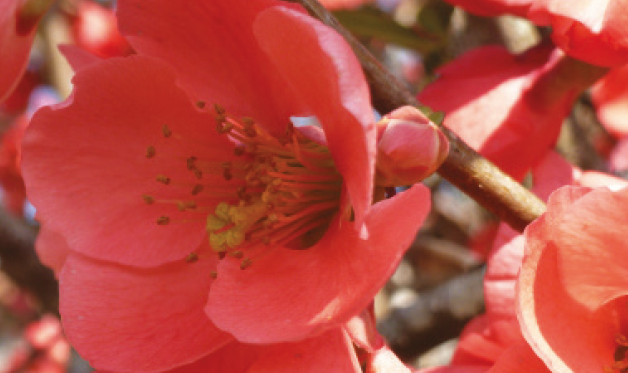PAULS PLANT OF THE MONTH: Flowering Quince
Quince is a useful addition to the garden for early spring colour when its bright orange / red flowers stud the bare thorny stems for weeks. I have never tried it but oncwers mature into quinces you can make a delicious jelly Easy to grow in virtually any soil and can also be trained on to a shady wall.
What to do in your garden in March
For many of us March is the month when we start to think about our gardens again after the worst of the winter has passed we hope! This year why not think of something new and perhaps have a go at planting a bottle garden, entering a local garden show , visiting a local open garden or try growing some fruit or veg. The ideas are endless trying something different will be fun. Remember the clocks go forward by one hour on Sunday 29 March as British Summer Time begins.
This months poem…
“The March wind roars, Like a lion in the sky, And makes us shiverAs he passes by , When winds are soft, And the days are warm and clear, Just like a gentle lamb, Then spring is here.” AUTHOR UNKNOWN
pauls jobs for the month
Flower Garden
•March is a good time to prune your roses. Shorten last year’s stems by half cutting just above a bud.
• Now is the ideal time to lift and divide congested clumps of snowdrops. Tease the plants apart gently and replant where you wish.
• You can increase your collection of dahlias by taking cuttings. Dormant tubers need to be brought into growth by placing them in pots or trays of compost. Water well and keep them warm in a light spot. When the shoots emerge and are around 3-4 inches long use a sharp knife to cut just above the point where the shoot emerges from the tuber. Remove the lower leaves from your cutting and pinch out the growing tip. Plant the cuttings in a small pot of potting compost keeping them warm indoors in a light spot. In a few weeks they will root and by the end of May should be able to plant your new dahlias in the garden.
Fruit Garden
• Final chance this month to prune your apple and pear trees before they start to bloom. Aim to remove any dead branches congested or crossing stems
Repair or lay a lawn
If it is not too wet the end of March is a good time to lay turf or sow grass seed. Follow these steps to improve your lawn
•Mow the grass at the highest setting on your mower.
• Scarify your lawn. Use a wire toothed rake to get rid of any moss and weeds. Don’t be surprised if this pulls out a lot of debris and leaves the lawn looking bare in some patches.
• Mow the grass again but this time at right angles to the first cut.
• It is worth spiking your lawn every year especially if you use your lawn a lot. The purpose of spiking a lawn is to make air holes in the turf and so alleviate compaction which leads to poor drainage and growth of moss. Just use a garden fork and every 6 inches stab the fork in around 4 inches.
• If your lawn has some bare pat a fork and apply some grass seed. Make sure to keep it watered. Alternatively buy a square of turf for a quick fix
• Finally give your lawn a tonic with a spring lawn feed.
Vegetable Garden
• Plant potatoes and earth up as required.
• Plant onion sets 4” to 6” apart and 12” between rows.
• Plant broad beans, parsnips and carrots

